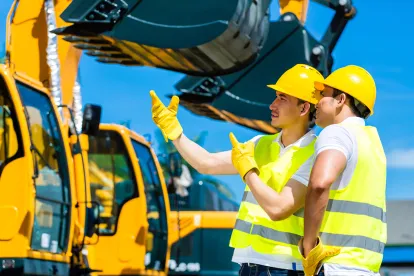On May 27, 2020, the Occupational Safety and Health Administration (OSHA) updated its guidance for employers performing construction work of all types. The agency’s guidance is not a standard or regulation, so it is not legally binding. Nonetheless, construction industry employers may want to consider OSHA’s recommendations when developing and updating their workplace safety and health plans, for two reasons. First, the guidance indicates which measures OSHA might allege are required by the Occupational Safety and Health Act’s General Duty Clause, just as it has done with heat stress, workplace violence, and other hazards for which it has no specific standard. Second, the document may indicate what employees may expect their employers to do as more people get back to work.
Risk-Level Assessment
OSHA recommends that employers assess hazards, evaluate risks, and implement controls based on the four exposure risk levels OSHA has used for all of its COVID-19–related guidance and recommendations. Notably, OSHA indicates that the “Very High” risk level is “not applicable for most anticipated work tasks” in the industry. The “High” risk level is for tasks requiring workers to enter “an indoor site occupied by people such as other workers, customers, or residents suspected of having or known to have COVID-19,” such as a nursing home or other healthcare facility. The “Medium” risk level is for “tasks that require workers to be within 6 feet of one another” or “customers, visitors, or members of the public.” Finally, the “Lower” risk level covers tasks that “allow employees to remain at least 6 feet apart and involve little contact with the public, visitors, or customers.” So OSHA primarily, but not exclusively, recommends reduced contact and proximity to others. OSHA recommends—but, again, does not require—that employers conduct a job hazard analysis (JHA) focused on the specific risk level of the analyzed tasks.
Indoor Construction Environments With High Risk of Exposure
OSHA’s guidance focuses primarily (but not exclusively) on indoor construction environments in the High risk level. For engineering controls, OSHA recommends using physical barriers, such as closed doors, walls, or even plastic sheeting barriers.
OSHA emphasizes that employers should use engineering controls so that employees need not be required to use N95 respirators and other personal protective equipment (PPE). As an example of engineering controls, OSHA mentions “water delivery or dust collection systems that will further reduce ambient dust when cutting, breaking, jackhammering, or drilling.” OSHA does not, however, make such a recommendation for outside construction environments or even indoor environments not in the High risk level.
For administrative controls, OSHA recommends employers use questions for screening work assignments when “scheduling indoor construction work to assess potential exposures and circumstances” before sending workers inside. OSHA recommends employers first ask if the work is “essential, urgent, or emergency work,” and if so, use a JHA to determine how to best minimize exposure.
If workers must enter home environments or areas where construction is ongoing in occupied buildings, OSHA recommends implementing standard operating procedures and employee training. Those procedures could include requesting any quarantined or isolated nonworkers (i.e., residents) to remain physically separated from workers, asking residents to communicate with workers remotely instead of in person, and asking residents to wear face coverings. OSHA also recommends taking measures to ensure that indoor working areas have adequate air flow.
Training for Construction Workers
OSHA recommends that construction workers be trained on COVID-19–related topics, such as:
- recognizing the signs and symptoms of the disease;
- understanding how the disease spreads, and how infected people can be asymptomatic and still spread the disease;
- the need to follow company policies and procedures;
- social distancing and hygiene practices;
- the use of PPE; and
- the importance of staying home if sick.
The amount of training an employer should do for a particular job site or task will depend on the prior determination of the risk level. OSHA’s guidance indicates that employees in occupied indoor worksites will require broader training.
Cloth Face Coverings in Construction?
OSHA clarified in bold type that “Cloth face coverings are not PPE,” and “[t]hey are not “appropriate substitutes for PPE,” such as N95 respirators or medical face masks. This is important because it relieves employers of any requirement to conduct written worksite assessments and training for face coverings, which would be required of any PPE. The agency recommends face coverings as a public health measure and notes that cloth face coverings protect other people, not the wearer. But OSHA does not require their use on a construction site. As OSHA’s guidance reminds, when a respiratory hazard exists, employers must comply with OSHA’s Respiratory Protection standard (29 C.F.R. Section 1910.134).
Other Safe Work Practices
OSHA’s updated guidance also recommends employers consider a wide range of other safe work practices, such as screening all visitors; adopting staggered work schedules; identifying “choke points where workers are forced to stand together”; “implement[ing] policies to maintain social distancing”; coordinating site deliveries to minimize contact and requiring delivery personnel to remain in their vehicles, if possible; implementing “a rigorous housekeeping program to reduce dust levels”; and minimizing in-person meetings of all types, such as toolbox talks and safety meetings.
Key Takeaways
OSHA’s updated construction guidance provides far greater detail and recommendations than the agency’s initial attempt. Although much of the content is specifically directed toward construction work occurring indoors, construction employers of all types are likely to find the recommendations useful. As with all workplace hazards, assessment, abatement, engineering and physical controls, training, and work practice controls are key safety elements.





 />i
/>i

